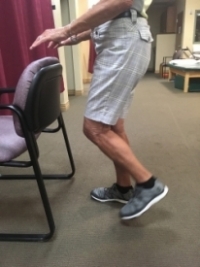Evidence shows as individuals age their balance diminishes, depending on their activity level.Practicing balance activities daily while maintaining lower extremity strength reduces the risk of falls. Knowing how severe your balance loss is provides an incentive to improve. Retesting periodically indicates improvement. Two tests are fairly reliable. Also test for 30 seconds recording how many times you touch the chair. As the number goes down, it indicates improvement.
Balance activities need to be completed on a consistent basis, challenging the brain, making the activities more difficult achieves the result.
Maintain Pilates Posture stand erect, by elongating the spine, keep the head on the shoulders, not the chest. pull belly button upwards to the spine pulling pelvis up and level) Think of the pelvis as a bucket, keeping it level. Breathe out maintaining the level pelvis.
1. Single leg stance 30 Seconds
Stand on one leg , other leg not touching static leg. Hold the position, maintaining the posture. No body swaying, etc. When toe touches other leg or floor time ends. Alternative method: stand on one leg for 30 seconds. Record each time one needs to touch chair to regain balance.
